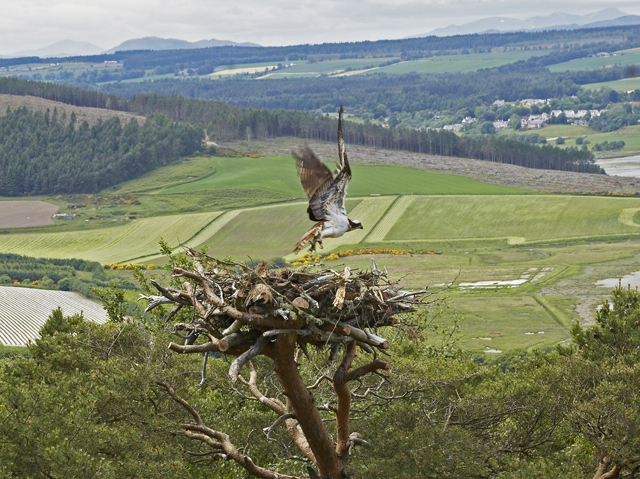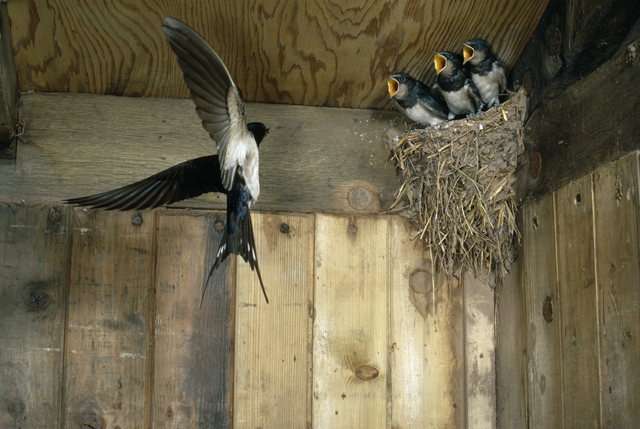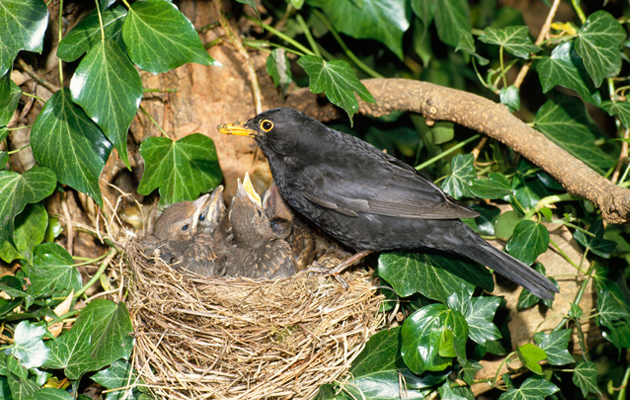As birds busy themselves with rearing young, we take a look at 8 birds and consider how they construct their nests.
A century ago, it would have been difficult to find a country lad who didn’t know the difference between a song thrush’s nest and that of a blackbird or who couldn’t tell you where best to look to find a clutch of sky-blue hedge-sparrow eggs.
Here we reveal how to identify bird nests:
 Blackbird
Blackbird
Hen blackbirds, rather than the cocks, usually choose the location for their nest and, although trees or bushes are the favourites, nests in sheds or buildings are not unusual. Among the more bizarre sites recorded are the engine of a parked aircraft and even a tractor in constant use. One nest was found 100ft high in an Edinburgh sycamore.
The nest itself is a substantial cup, typically made from dry grasses, roots, stalks, moss and mud, but it’s not unusual for sweet papers or pieces of string to be included. The cup itself is lined with dry grasses. If you watch a hen blackbird building her nest, you’ll find she shapes it with her breast, pulling loose grasses down towards her.
 Wren
Wren
When it comes to enthusiasm for nest building, few birds can rival the cock wren. Every spring, he builds a number of neat, domed nests, each one made of moss, dry grass and dead leaves, sometimes with a little bracken. These are generally known as false or cock nests, for the hen will eventually select the one she likes and she takes sole responsibility for lining the nest chamber with feathers, resisting any offers of help from her mate.
The wren may use the same nest for repeat broods, although it may well be employed again in the winter for roosting. Because of their small size, wrens struggle to maintain body heat during a winter night and often roost communally.
 Osprey
Osprey
Few birds are as site-faithful as ospreys—established pairs almost always return to their old nest, year after year. The nests themselves are often huge, the result of decades of annual additions. At the peak of nest-building, a pair may make more than 100 trips a day, bringing in sticks and branches. As egg-laying approaches, the birds will bring softer materials, such as grasses or even seaweed, to line the nest. Typically, osprey eyries are located in exposed sites where they’re subject to gale-force winds, so their stability depends on their size and weight. Although a typical Scottish osprey eyrie will be on a large, flat-topped pine tree, these birds are quick to adopt nesting platforms provided for them.
 Reed warbler
Reed warbler
In recent years, we’ve unravelled numerous mysteries of the bird world, such as the migration route of the cuckoo (revealed by satellite tagging). However, many still remain, such as how the cock reed warbler manages to wind the very first blade of grass around the three to five reed stems that will eventually support his woven nest.
A finished reed-warbler nest is a beautifully woven basket of long, dried grasses, lined with hairs or similarly fine materials. It’s a deep and comfortable cup and, here, the clutch of four or five eggs will be laid. Many cuckoos start their life in reed-warbler nests, as the reed warbler is a favoured host.
 Song thrush
Song thrush
In size and construction, even choice of site, the nest of the song thrush is much like that of the blackbird. There is, however, one major difference. The song thrush invariably includes a smooth lining, made from a mixture of mud, clay, cow dung (if available) and rotten wood, mixed with saliva, forming a hard, cork-like base. Building such a nest is a lengthy business: most of the work falls to the female, although sometimes with a little help from her mate.
The first nest of the year may take two weeks or more to build, but those made later in the season are often put together much more quickly, with a corresponding loss in quality. However, song thrushes will reuse the original nest for subsequent broods. In North-Eastern Europe, old song-thrush nests provide the favoured nest site for green sandpipers.
 Swallow and house martin
Swallow and house martin
Both swallows and martins make their nests from mud pellets, cemented with the bird’s saliva, but although the martin’s nest is a domed construction, built under a ledge, gable or overhang, that of the swallow is an open cup, typically situated on a shelf or beam in a barn or building. Dry springs are a problem for both species: if mud is unavailable, building is impossible. When the mud quality is poor, it often results in the nest collapsing later in the season.
Constructing the nest is labour intensive, with as many as 1,200 journeys needed; most of the work takes place between 6am and 8am, allowing the mud to harden during the day. Both species will adopt artificial nests—a pair of swallows nests in my cart lodge every year, using an artificial nest, usually rearing two broods of five.
 Long-tailed tit
Long-tailed tit
According to W. H. Hudson, writing in his classic British Birds (1895), ‘the nest of the long-tailed titmouse is a marvel of bird architecture: a domed oval composed of moss, lichens, and hair closely felted, and the interior thickly lined with feathers. [Victorian ornithologist William] McGillivray says that the feathers from one nest numbered 2,379.’
Long-tailed tits start breeding early in the spring, building among brambles, in gorse or lichen-covered thorn bushes in which the nests are difficult to find. The nests are rarely more than a few feet off the ground. Amusingly, you can spot incubating females because continually squeezing into the confined space of the nest causes their tails to bend and become misshapen.
 Buzzard
Buzzard
Large, bulky and often conspicuous, the nest of the buzzard is an elaborate affair. The basic nest is made from stout sticks and includes a wide platform around the shallow, lined cup in the centre. The platform allows for the fact that the young buzzards will be in the nest for 6–7 weeks after hatching, giving them plenty of room to move around.
What sets the buzzard apart from other raptors is the birds’ habit of decorating their nest with freshly picked foliage, although some individuals are much keener on such embellishments than others. Anything from sprays of rowan leaves to young fronds
of bracken may be used.

How to salute a magpie
Acknowledging and hailing magpies is a long-held country superstition. We reveal how to salute a magpie, and other fascinating facts.

Which bird will get your vote?
Have you voted for Britain's National Bird?




